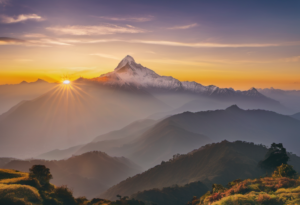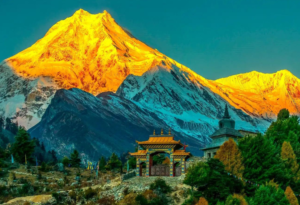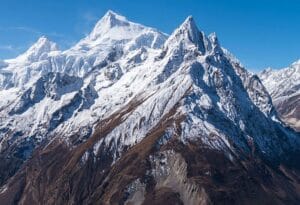The Tsum Valley Trek, nestled in the remote Manaslu Region of Nepal, offers an adventure like no other. Known as the “Hidden Valley,” this trek provides a unique opportunity to explore an area rich in Tibetan culture and heritage. With the majestic peaks of Ganesh Himal, Sringi Himal, and Boudha Himal as a backdrop, trekkers are treated to breathtaking mountain scenery at every turn.
Starting from Soti Khola, the journey takes you through traditional villages such as Machha Khola, Philim, and Lokpa. As you ascend, you’ll pass through lush alpine and rhododendron forests, cross glacial rivers, and experience the tranquil beauty of the Shyar Khola Valley. Highlights of the trek include visits to sacred Buddhist monasteries like Mu Gompa and Rachen Gompa, where the spiritual atmosphere is palpable.
The Tsum Valley is a restricted area, requiring a special permit, which adds to its allure as a non-touristic trek. The trail offers a mix of teahouse accommodations and homestays, providing a genuine glimpse into the local way of life. This trek is perfect for those seeking a cultural trek with less crowded paths, allowing for intimate encounters with the region’s ethnic diversity and traditional practices.
At higher altitudes, the trek becomes more challenging, especially as you approach the Larke Pass. However, the effort is rewarded with stunning vistas and a deep sense of adventure. The Tsum Valley Trek is ideal for trekkers looking for a sacred and serene escape, combining natural beauty with cultural immersion.
Embark on the Tsum Valley Trek for an unforgettable journey through one of Nepal’s most secluded and enchanting regions. Whether you’re captivated by the serene landscapes or the rich cultural experiences, this trek promises the adventure of a lifetime.
Tsum Valley Trek Highlights
- Immerse yourself in the less-explored beauty of Tsum Valley, with unique Tibetan-influenced culture and customs.
- Mu Gompa, Ganesh Himal Base Camp, and Tibet border.
- Witness the direct influence of Tibetan Buddhism as you visit chortens, monasteries, and Gompas.
- Visit ancient monasteries like Gompa Lungdang, Rachen Gompa, and Mu Gompa.
Best time for Tsum Valley Trek
The best time to trek the Tsum Valley is during the spring and autumn seasons in Nepal. These periods offer the most favorable weather conditions, clear skies, and optimal temperatures for trekking.
Spring Season (March to May)
Spring is one of the most popular times to trek in the Annapurna Region, which includes the Tsum Valley Trek. During this season:
- Weather Conditions: The weather is generally mild and pleasant, with daytime temperatures ranging from 5°C to 25°C at lower elevations, while higher elevations are cooler.
- Clear Views: The skies are typically clear, providing stunning views of the surrounding mountains, including Ganesh Himal, Sringi Himal, Himalchuli, Buddha Himal, Ngadi Chuli, Shringi Himal, and Manaslu.
- Flora: The rhododendron and pine forests are in full bloom, creating a vibrant landscape with colorful flowers and lush greenery.
- Crowds: Though this is a popular trekking season, the Manaslu Circuit Trek trail remains less crowded than other treks in the Annapurna Region.
Autumn Season (September to November)
Autumn is another ideal time to trek the Tsum Valley this season:
- Weather Conditions: The weather is stable with clear skies, low humidity, and pleasant temperatures, similar to spring. Daytime temperatures range from 5°C to 20°C at lower elevations, while it is cooler at higher altitudes.
- Clear Views: Autumn is known for its crisp air, providing excellent visibility of the surrounding peaks and landscapes.
- Festivals: This season aligns with major Nepali festivals like Dashain and Tihar, offering cultural insights and opportunities to experience local traditions.
- Crowds: Though autumn is the peak trekking season in Nepal, the Tsum Valley Trek trail is less crowded compared to other treks.
Off-Season Considerations
While spring and autumn are the best time for the Tsum Valley Trek, some trekkers prefer off-season trekking for a unique experience. However, these periods come with challenges:
- Winter Season (December to February): Trekking in winter offers solitude and stunning snowy landscapes, but temperatures can drop significantly, especially at higher elevations. Trails might be icy, and some teahouses could be closed.
- Monsoon Season (June to August): The monsoon brings heavy rain, making trails slippery and increasing the risk of landslides and leeches. The clouds and rain can also obstruct mountain views.
Overall, spring and autumn offer the best combination of weather, views, and cultural experiences, making them the ideal times to trek the Tsum Valley. If you’re planning a trip during the off-season, be prepared for additional challenges and always check weather forecasts and trail conditions in advance.
 Trekking
Trekking
 Trekking
Trekking
 Trekking
Trekking
